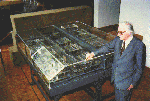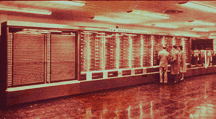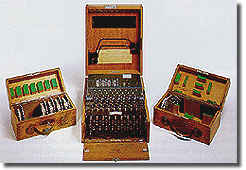click on the home button to go to the thocp home page
|
The Pre Industrial Era 1940-1944 |
pre history | antiquity
| pre industrial era | industrial
era
1886 -
1900 - 1927
- 1938 - 1940
- 1944
| Related Articles |
| Related Resources |
|
|
![]() The group managed
by George Stibitz produced several calculators.
The group managed
by George Stibitz produced several calculators.
The first, called the Complex Computer, employing over 9,000 telephone relays,
is completed in 1940. And is used for multiplication and division of complex
numbers, it could perform one addition or subtraction every three tenths of
a second.
Programming instructions and routines were entered via paper tape. The system
has a form of time-sharing.
Six Teletype units can be connected to the computer to enter or print data.
The system can handle multiprocessing by combining a number of computers to
solve several problems concurrently.
![]() Konrad Zuse
writes a chess program (between 1942 and 1945) in Zuse's own developed programming
language: Plankalkuel, a high-level language for which no compiler will be available
until the 1990's.
Konrad Zuse
writes a chess program (between 1942 and 1945) in Zuse's own developed programming
language: Plankalkuel, a high-level language for which no compiler will be available
until the 1990's.
It precedes Shannon's future article about computer chess by almost five years.
The code was published in 1972 in "Der Plankalkül" (10)
Prof. Rojas's group of the FUB Germany will re-implement the same program in
Java in may 2000 and thus make it available to the world via the Web: click
here
![]() First Color
TV broadcast
First Color
TV broadcast
![]() Russell Ohl
discovers P-N junction by accident while refining silicon, the basic material
of integrated circuits or chips.
Russell Ohl
discovers P-N junction by accident while refining silicon, the basic material
of integrated circuits or chips.
A crack in one of his crystals leads to the observation that current was flowing to one side only while shining light on one side of the crystal. And depending on the inpurity of the crack's side current flows. This is the basic principle of solar cells and transistors alike.(4)
![]() Konrad Zuse (Germany)
constructs the first electro mechanical digital computer that is programmable.
Konrad Zuse (Germany)
constructs the first electro mechanical digital computer that is programmable.

On the 12th of May, after the experimental models Z1(7) and Z2, Zuse completes a working model: the Z3.
The Z3 can be considered the world's first fully functional automatic digital computer. It utilized the binary number system and could perform floating-point arithmetic (13)Typical for the Z3 is that it is controlled by a program based on the binary system (Leibnitz).
The machine is build from 2600 relays, electromagnetic switches with two switch positions. More than half is used for memory, ±600 for CPU and ±600 for the "operating system".
The Z3 is the first binary computer on the world. Despite what is said about Atanasoff and Aiken's machines.Zuse hires a mathematician, Arnold Fast, to program it. August Fast lives in the blind institute in Berlin. Fast otherwise deemed to be useless for the war effort now can make himself useful. Fast has a very good understanding of mathematics. Zuse and Fast together develop programs for the Z3 and the next computer: Z4 (1942).
Arnold Fast is considered to be the world's first professional programmer.Note: Babbage (UK, around 1840) planned but was not able to build a decimal, programmable machine. Atanasoff's ABC - completed in 1942 - and Eckert und Mauchly's decimal ENIAC (US, 1945/46) were just special purpose calculators (the first automatic calculators, however, date back to Pascal (1640) and Leibniz (1670)). They were not freely programmable. Neither was Turing et al.'s Colossus (UK, 1943-45) used to break the Nazi code. Aiken's programmable MARK I (US, 1944) was still decimal and had no separation of storage and control.(2)
![]() C. Marcus Olson , of Du Pont 1936
- 1971, has been credited as the discoverer of the process to make silicon really
pure - 0.001 percent impurity or less - the basic raw material of which are
built the transistor and the integrated circuit and, indirectly, the computer
and everything else made from microelectronic elements. (3)
See also timeline 1824
C. Marcus Olson , of Du Pont 1936
- 1971, has been credited as the discoverer of the process to make silicon really
pure - 0.001 percent impurity or less - the basic raw material of which are
built the transistor and the integrated circuit and, indirectly, the computer
and everything else made from microelectronic elements. (3)
See also timeline 1824
![]() An improved version of the Z4
is used to calculate the aerodynamic characteristics of wings and rudders. None
the less the Z4 is still a mechanical machine.
An improved version of the Z4
is used to calculate the aerodynamic characteristics of wings and rudders. None
the less the Z4 is still a mechanical machine.
Zuse fights against the problem of not having adequate software for his computer. But that will be the same case in the far future too. This time the reason is because of the war and therefor his resources are very limited.
Nearing the end of the war there is hardly any appropriate material for his computers, Zuse has to improvise and salvages materials from telephone exchanges, uses rejected materials from the movie industry (read: propaganda) and so on. This makes him very inventive of course. And in the light of this difficulties one is again left to wonder what would have happened with the computer industry in Germany, let alone the war, if Zuse would have had the proper allocation of resources.Also as a result of lack of materials Zuse directs his attention towards development of software. This results in Plankalkuel. The archetype of the programming languages of today.
Konrad Zuse and Helmut Schreyer (Austria) put up a computer design with electronic vacuum tubes. This machine would work a thousand times faster as whatever the Germans have at this time. But the German military command is so convinced of a speedy victory, in their eyes it would not be longer than two years. Their conclusion is that it is not worthwhile in their view. Also Hitler imposes an embargo on all long term projects. A missed change! Well, that is depending how you look at it, but for the free world it is extremely good luck.
![]() Engineers of IBM develop a multiplier.
The center base for this multiplier is the vacuum tube. The machine resulting
from it is thousand of times faster than anything in existence of electro -
mechanic calculators.
Engineers of IBM develop a multiplier.
The center base for this multiplier is the vacuum tube. The machine resulting
from it is thousand of times faster than anything in existence of electro -
mechanic calculators.
![]() US Army commissioned Dr. John
Mauchly and John Eckert to design a electronic machine that could compute trajectory
table quickly. The result will be ENIAC (Electronic Numerical Integrator and
Computer) in 1946. Later it was classified as calculator.(13)
US Army commissioned Dr. John
Mauchly and John Eckert to design a electronic machine that could compute trajectory
table quickly. The result will be ENIAC (Electronic Numerical Integrator and
Computer) in 1946. Later it was classified as calculator.(13)
![]() The first programmable calculator
designed by Howard Aiken is ready: the Harvard or MARK I. The construction is
sponsored by IBM as mentioned before; and they call the machine: Automatic Sequence
Controller - ASCC.
The first programmable calculator
designed by Howard Aiken is ready: the Harvard or MARK I. The construction is
sponsored by IBM as mentioned before; and they call the machine: Automatic Sequence
Controller - ASCC.
Aiken smartly makes use of existing equipment. Such as the IBM Selectric typing
machines for input and output. Also the punch card technology of IBM is used
and the adding, divide and multiplier devices of Bryce are directly incorporated
into the MARK I. The system is operated by a program on a paper punch tape.
A find of Aiken(8)
and looks like a further development of the paper punch card.

The MARK-I is absolutely the top in the electro mechanical era. The machine,
operational in 1944, occupies an entire building. After completion IBM donates
the machine to the Harvard university.
The machine measures 10,60 m long by 2,60 m high, weighs 5 metric tons, contains
800.000 elements, and curiously enough uses a few tons of ice per day for its
cooling, multiplication of 2 numbers of 23 digits is done in 3 seconds.
![]() Grace Hopper (1906-1991), involved
with the Mark-I programming project, starts to develop a series of base
codes representing often used bit sequences. To these base codes are given named
labels. These labels or codes will be called pseudo code, opcode,
or mnemocode. With this she brings programming to a higher level.
Grace Hopper (1906-1991), involved
with the Mark-I programming project, starts to develop a series of base
codes representing often used bit sequences. To these base codes are given named
labels. These labels or codes will be called pseudo code, opcode,
or mnemocode. With this she brings programming to a higher level.
![]() Drs. John Mauchly and Presper
Eckert think that a digital calculator can do the job to calculate tables faster
than contemporary electro mechanical computers.
Drs. John Mauchly and Presper
Eckert think that a digital calculator can do the job to calculate tables faster
than contemporary electro mechanical computers.
So, in April, 1943, through the Moore School of Engineering at Pennsylvania,
they submit a memo describing an electronic analyzer that will compute a trajectory
and complete a table within 2 days.
The army buys the machine that is constructed at an expenditure
of appr. 200,000 man-hours. Being a fully electronic machine, the ENIAC
(an acronym for Electronic Numerical Integrator and Calculator) uses vacuum
tubes. It contains no moving parts except for input-output gear. It has 500,000
soldered joints, 18,000 vacuum tubes, 6,000 switches and 500 terminals. Counting
is performed by generating electronic pulses. The machine operats on the basis
of the decimal system. Output is on punched cards.
ENIAC originally does not contain an internal
store. However, during construction, the idea is discussed and a store will
be added later.
The size of its numerical word is 10 decimal digits, and it can multiply two
such numbers at the rate of 300 results per second, by finding the value of
each product from a multiplication table stored in its memory. The ENIAC
is about 1,000 times faster than the prior generation of relay computers.(14)
The machine will be completed in 1945.
![]() One more insight is needed to
create the the modern computer: the von Neumann architecture. John von Neumann
(USA) develops the first programmable calculator with a memory.
One more insight is needed to
create the the modern computer: the von Neumann architecture. John von Neumann
(USA) develops the first programmable calculator with a memory.
John Von Neumann realizes that significant benefits and flexibility
can be achieved by writing the program instructions to allow dynamic modification
while the program is running. This enabled hardware to act "intelligent."
Von Neumann meets these two needs by providing a special type of machine instruction
called conditional control transfer--which permits the program sequence to be
interrupted and reinitiated at any point--and by storing all instruction programs
together with data in the same memory unit, so that instructions can be arithmetically
modified in the same way as data.
As a result of these and several other techniques, computing
and programming becomes faster, more flexible, and more efficient. The
new instructions in subroutines performs far more computational work. Frequently
used subroutines become reusable avoiding reprogramming for each new problem.
Programs can be kept intact in "libaries" and read into memory as needed from
a secondary storage place such as punched cards or tapes. The all-purpose
computer memory becomes the assembly location for various program parts.
The first generation of modern programmed electronic computers to take advantage
of these improvements will appear in 1947. They will use the first Random
Access Memory (RAM), generally consisting of approximately 8,192 Bytes.(14)
![]() In 1944, the army asks the Moore
School to build a more powerful computer than the ENIAC.
In 1944, the army asks the Moore
School to build a more powerful computer than the ENIAC.
 |
The Germans are using a coding device called Enigma that worked with different keys that could be set at random. The machine was originally invented by a Polish engineer. How it came into the hands of the Germans is not clear. But the fact remains that because of this variable key used by this machine the British had a hard job in cracking it. |
![]() M.H.A. Newman, head of the department
that cracked the Enigma code employs two engineers from the British telecom
- T.H. Flowers en S.W. Bradhurst. These two propose a new concept that
resulted in the COLOSSUS Mk I. The first full electronic computer. In
December this year it is finished and ready to run.
M.H.A. Newman, head of the department
that cracked the Enigma code employs two engineers from the British telecom
- T.H. Flowers en S.W. Bradhurst. These two propose a new concept that
resulted in the COLOSSUS Mk I. The first full electronic computer. In
December this year it is finished and ready to run.
The system appeared to be so fast that the story goes that the Allies got the
messages during the desert war in north Africa, much earlier then the German
Command.
|
The British government sets up a research center to crack the secret
codes of the German army. The complex known as Bletchley park is near
London. The project is surrounded with the utmost secrecy. And it is not
until 1996 that (most of) the details are released to the public domain.
It is the so called Secrecy Act that keeps interesting stuff secret for
over 50 years and still does! This is the so called "Bomb" a code cracking machine for the German enigma code. It did not do well and engineers start work on the Colossus I Some prototypes are constructed: the Heath Robinson and Super Robinson. But they prove to be unreliable. The Bletchley project starts to engineer a new machine. Machines build at Bletchley are called Colossus. This because of the tremendous amounts of vacuum tubes (over 2000). Demands put to the engineers building the machines are put to the extreme because of time pressure and complexity of code cracking. |
 |
|
|
Later in the nineties the Bletchley Museum people will reconstruct the Colossus but are frustrated very much by the Secrecy Act in doing so. |
|
![]() The term Hacker is coined at
the MIT ( Massachusetts Institute of Technology USA) In the sixties a group
of students kept themselves busy with a model railway. The members of this group
were called hackers because of their interest in circuits, cabling etc.
The term Hacker is coined at
the MIT ( Massachusetts Institute of Technology USA) In the sixties a group
of students kept themselves busy with a model railway. The members of this group
were called hackers because of their interest in circuits, cabling etc.
In this view the people of Bletchley park are probably the first hackers in history.
|
This is one of the famous "He could not be wrong more" quote by Thomas J. Watson: "I think there would be a market for about five computers" IBM later (1952) denies that Watson said this, but may have used it in the context of IBM computer sales in that particular year. |
![]()
| Last Updated on October 4, 2004 | For suggestions please mail the editors |
Footnotes & References
| 1 | http://people.freenet.de/Behning/Computergeschichte_bis1949.html |
| 2 | ref: Juergen Schmidhuber |
| 3 | http://smithsonianchips.si.edu/olson/index.htm |
| 4 | A more precise explanation can be found at: http://www.pbs.org/transistor/science/events/pnjunc.html (last accessed 4 okt 2004) |
| 9 | courtesy IBM corp |
| 10 | Reports of the GMD, N. 63 |
| 11 | Real time = you can enter data which are processed right after you enter it |
| 12 | courtesy Ordnance Ballistic Research Laboratories, Aberdeen Proving Ground |
| 13 | Marian Bozdoc, Auckland NZ, www.bozdoc.f2s.com |
| 14 | taken from www.maxframe.com/HISTORY.HTM |